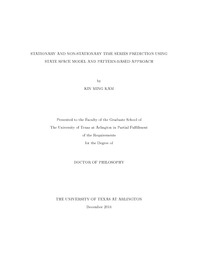| dc.description.abstract | The motion-adaptive radiotherapy techniques are promising to deliver ablative radiation doses to tumor with minimal normal tissue exposure by accounting for real-time tumor movement. However, a major challenge of successful applications of these techniques is the real-time prediction of target motion to accommodate system delivery latencies. Predicting respiratory motion in real-time is challenging. The current respiratory mo-tion prediction approaches are still not satisfactory in terms of accuracy and interpretability due to the com-plexity of breathing patterns and the many sources of variability across patients. In this paper, we propose a novel respiratory motion prediction approach based on future values of best-matching patterns. In particu-lar, there are three major ingredients of this approach: (1) construct a real-time accumulated pattern library by orthogonal polynomial approximation using a sliding window approach, (2) find k nearest-neighbor patterns in the pattern library and apply a two-step approach to screen out the disturbing patterns and find out the fi-nal predictive patterns. (3) the final prediction is made using the bootstrapped mean of the 'future values' of the selected predictive patterns given a prediction hori-zon. Based on a study of respiratory motion traces of 27 patients with lung cancer, the proposed prediction ap-proach has generated consistently significant higher ac-curacies than the current respiratory motion prediction approaches, particularly for long prediction lengths.There has been much interest in the beneficial effects of musical training on cognition. Previous studies have indicated that musical training was related to better working memory and that these behavioral differences were associated with differences in neural activity in the brain. However, it was not clear whether musical training impacts memory in general, beyond working memory. By recruiting professional musicians with extensive training, we investigated if musical training has a broad impact on memory with corresponding electroencephalography (EEG) signal changes, by using working memory and long-term memory tasks with verbal and pictorial items. Behaviorally, musicians outperformed on both working memory and long-term memory tasks. A comprehensive EEG pattern study has been performed, including various univariate and multivariate features, time-frequency (wavelet) analysis, power-spectra analysis, and deterministic chaotic theory. The advanced feature selection approaches have also been employed to select the most discriminative EEG and brain activation features between musicians and non-musicians. High classification accuracy (more than 95\%) in memory judgments was achieved using Proximal Support Vector Machine (PSVM). For working memory, it showed significant differences between musicians versus non-musicians during the delay period. For long-term memory, significant differences on EEG patterns between groups were found both in the pre-stimulus period and the post-stimulus period on recognition. These results indicate that musicians' memorial advantage occurs in both working memory and long-term memory and that the developed computational framework using advanced data mining techniques can be successfully applied to classify complex human cognition with high time resolution. | en_US |

